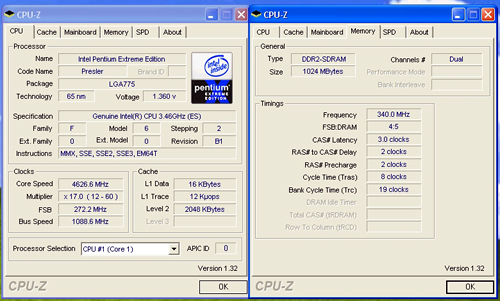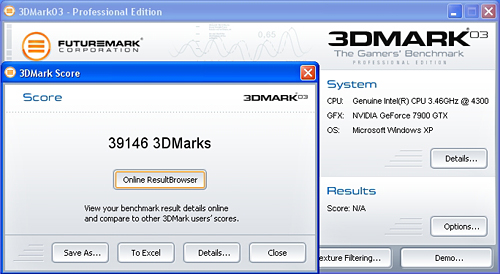NVIDIA nForce4 SLI XE: Enthusiast Features on a Budget
by Gary Key on March 23, 2006 12:05 AM EST- Posted in
- Motherboards
FSB Overclocking Results
This board is a competitve overclocker when comparing it to the Intel 975X boards for maximum CPU speeds, but it still trails the 975X boards in FSB speeds as our Asus and Gigabyte boards can reach a 340FSB level for performance testing although their application stable FSB levels are slightly above 300. At these settings, the system is able to complete all of our benchmark test suites three consecutive times along with SuperPI and run Prime95 for a minimum of four hours. We lowered the CPU multiplier to 14, but it could not overclock past a 268FSB setting with our test CPU. We changed the LDT ratio to several different settings without success. These results continue the pattern that we see in the nForce4 Intel Edition chipsets not reaching high FSB speeds, yet being very successful in overclocking the CPU at standard FSB settings.
Memory Stress Testing
This memory stress test looks at the ability of the ECS C19-A SLI to operate at the officially supported memory frequencies of 533MHz DDR2, at the best performing memory timings that the Corsair CM2X512A-5400UL revision 1.3 will support. Note that this memory is rated at 3-2-2-8 timings for 667MHz operation.
The ECS C19-A SLI was very stable with 2 DDR2 modules in Dual-Channel at the settings of 3-2-2-8 at 2.1V. We will now install all four available memory slots that result in more strenuous requirements on the memory subsystem than testing 2 DDR2 modules on a motherboard.
The ECS C19-A SLI was completely stable with 4 DDR2 modules in Dual-Channel operation at the settings of 3-3-3-8, but it required the command rate to be increased to 2T.
| Front Side Bus Overclocking Testbed | |
| Processor: | Pentium 4 Smithfield LGA 775 840EE Dual Core 3.2GHz |
| CPU Voltage: | 1.4750V (1.4000V default) |
| Memory Settings: | 3-2-2-8 at 667MHz |
| Memory Voltage: | 2.2V |
| SPP Voltage: | Default |
| FSB Voltage: | Default |
| Cooling: | Zalman CNPS 9500 |
| Power Supply: | PC Power and Cooling 850 SSI |
| Maximum CPU OverClock: | 254fsb x 17 (4318MHz) +35% |
| Maximum FSB OverClock: | 268fsb x 16 (4288MHz) +34% |
This board is a competitve overclocker when comparing it to the Intel 975X boards for maximum CPU speeds, but it still trails the 975X boards in FSB speeds as our Asus and Gigabyte boards can reach a 340FSB level for performance testing although their application stable FSB levels are slightly above 300. At these settings, the system is able to complete all of our benchmark test suites three consecutive times along with SuperPI and run Prime95 for a minimum of four hours. We lowered the CPU multiplier to 14, but it could not overclock past a 268FSB setting with our test CPU. We changed the LDT ratio to several different settings without success. These results continue the pattern that we see in the nForce4 Intel Edition chipsets not reaching high FSB speeds, yet being very successful in overclocking the CPU at standard FSB settings.


Memory Stress Testing
This memory stress test looks at the ability of the ECS C19-A SLI to operate at the officially supported memory frequencies of 533MHz DDR2, at the best performing memory timings that the Corsair CM2X512A-5400UL revision 1.3 will support. Note that this memory is rated at 3-2-2-8 timings for 667MHz operation.
| ECS C19-A SLI Stable DDR2-667 Timings - 2 DIMMs (2/4 slots populated - 1 Dual-Channel Bank) |
|
| Clock Speed: | 200MHz (800FSB) |
| Timing Mode: | 667MHz - Default |
| CAS Latency: | 3 |
| RAS to CAS Delay: | 2 |
| RAS Precharge: | 2 |
| RAS Cycle Time: | 8 |
| Command Rate: | 1T |
| Voltage: | 2.1V |
The ECS C19-A SLI was very stable with 2 DDR2 modules in Dual-Channel at the settings of 3-2-2-8 at 2.1V. We will now install all four available memory slots that result in more strenuous requirements on the memory subsystem than testing 2 DDR2 modules on a motherboard.
| ECS C19-A SLI Stable DDR2-667 Timings - 4 DIMMs (4/4 slots populated - 2 Dual-Channel Banks) |
|
| Clock Speed: | 200MHz (800FSB) |
| Timing Mode: | 667MHz - Default |
| CAS Latency: | 3 |
| RAS to CAS Delay: | 3 |
| RAS Precharge: | 3 |
| RAS Cycle Time: | 8 |
| Command Rate: | 2T |
| Voltage: | 2.1V |
The ECS C19-A SLI was completely stable with 4 DDR2 modules in Dual-Channel operation at the settings of 3-3-3-8, but it required the command rate to be increased to 2T.










12 Comments
View All Comments
blackmetalegg - Friday, March 24, 2006 - link
"Unfortunately, we ran into an issue with this process as the clear CMOS process sometimes required the removal of the battery for the jumper process to work. This process is not acceptable, considering how well other BIOS recovery systems work."Sounds a lot like the reviewer is too lazy to use his finger to release the battery from its holder.
Gary Key - Friday, March 24, 2006 - link
Certainly not lazy as I removed the battery at least a dozen times during testing. The fact remains that having to remove the battery is not an acceptable option when the clear CMOS jumper does not work over 60% of the time because the bios self recovery routine fails 85% of the time when the memory settings are extended past the board's ability to boot properly. This only occurred a couple of times when setting the FSB past the board's limit.
kmmatney - Friday, March 24, 2006 - link
I hate removing the battery. I broke the flimsy battery clip off of one motherboard doing this, and had to solder new wires in place and dangle a new battery from it. Removing the battery for a BIOS clear is not good.cornfedone - Thursday, March 23, 2006 - link
Obviously this mobo wasn't tested before release or it wouldn't have all the problems it has.phillock - Thursday, February 1, 2018 - link
Sounds a lot like the reviewer is too lazy to use his finger to release the battery from its holder.https://jumjex.bandcamp.com/releases
Puddleglum - Thursday, March 23, 2006 - link
Not sure if it's worth fixing or not, but the Content Creation (Disk Controller Performance) chart shows the Biostar TForce4 in red, mistaken as the board being tested.smut - Thursday, March 23, 2006 - link
Is this going to be an Intel only board?Gary Key - Thursday, March 23, 2006 - link
Yes. The upcoming NVIDIA nForce 500 launch will address chipset updates to the AMD product family.
bldckstark - Thursday, March 23, 2006 - link
No, upon release the board will come with alternate CPU sockets included in the box. You got an AMD? Just pop out the Intel socket and plug in the AMD socket. Gat a VIA, Cyrix, or TI85 chip? Just break the chosen socket out of the plastic holders like a model car part.Oh, wait, I guess you want to know if ECS is going to make an AMD board. Duh.
Gary Key - Thursday, March 23, 2006 - link
Our next article will have a high resolution picture of the capacitors and other items of importance in a pop-up window. I am sure the capacitors utilized on this board will be of interest to you. ;->